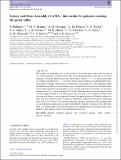Files in this item
Galaxy And Mass Assembly (GAMA) : time-scales for galaxies crossing the green valley
Item metadata
| dc.contributor.author | Phillipps, S. | |
| dc.contributor.author | Bremer, M. N. | |
| dc.contributor.author | Hopkins, A. M. | |
| dc.contributor.author | De Propris, R. | |
| dc.contributor.author | Taylor, E. N. | |
| dc.contributor.author | James, P. A. | |
| dc.contributor.author | Davies, L. J. M. | |
| dc.contributor.author | Cluver, M. | |
| dc.contributor.author | Driver, S. P. | |
| dc.contributor.author | Eales, S. A. | |
| dc.contributor.author | Holwerda, B. W. | |
| dc.contributor.author | Kelvin, L. S. | |
| dc.contributor.author | Sansom, A. E. | |
| dc.date.accessioned | 2019-10-16T09:30:04Z | |
| dc.date.available | 2019-10-16T09:30:04Z | |
| dc.date.issued | 2019-06 | |
| dc.identifier | 261905497 | |
| dc.identifier | 7fdf4aa5-9121-444c-a365-6a7bf3512766 | |
| dc.identifier | 85073168229 | |
| dc.identifier.citation | Phillipps , S , Bremer , M N , Hopkins , A M , De Propris , R , Taylor , E N , James , P A , Davies , L J M , Cluver , M , Driver , S P , Eales , S A , Holwerda , B W , Kelvin , L S & Sansom , A E 2019 , ' Galaxy And Mass Assembly (GAMA) : time-scales for galaxies crossing the green valley ' , Monthly Notices of the Royal Astronomical Society , vol. 485 , no. 4 , pp. 5559–5572 . https://doi.org/10.1093/mnras/stz799 | en |
| dc.identifier.issn | 0035-8711 | |
| dc.identifier.other | ArXiv: http://arxiv.org/abs/1903.07675v1 | |
| dc.identifier.uri | https://hdl.handle.net/10023/18685 | |
| dc.description.abstract | We explore the constraints that can be placed on the evolutionary time-scales for typical low-redshift galaxies evolving from the blue cloud through the green valley and on to the red sequence. We utilize galaxies from the GAMA survey with 0.1 < z < 0.2 and classify them according to the intrinsic (u* − r*) colours of their stellar populations, as determined by fits to their multiwavelength spectral energy distributions. Using these fits to also determine stellar population ages and star formation time-scales, we argue that our results are consistent with a green valley population dominated by galaxies that are simply decreasing their star formation (running out of gas) over a time-scale of 2–4 Gyr which are seen at a specific epoch in their evolution (approximately 1.6 e-folding times after their peak in star formation). If their fitted star formation histories are extrapolated forward, the green galaxies will further redden over time, until they attain the colours of a passive population. In this picture, no specific quenching event which cuts-off their star formation is required, though it remains possible that the decline in star formation in green galaxies may be expedited by internal or external forces. However, there is no evidence that green galaxies have recently changed their star formation time-scales relative to their previous longer term star formation histories. | |
| dc.format.extent | 5713684 | |
| dc.language.iso | eng | |
| dc.relation.ispartof | Monthly Notices of the Royal Astronomical Society | en |
| dc.subject | Galaxies: evolution | en |
| dc.subject | Galaxies: star formation | en |
| dc.subject | Galaxies: stellar content | en |
| dc.subject | Galaxies: structure | en |
| dc.subject | QB Astronomy | en |
| dc.subject | QC Physics | en |
| dc.subject | NDAS | en |
| dc.subject.lcc | QB | en |
| dc.subject.lcc | QC | en |
| dc.title | Galaxy And Mass Assembly (GAMA) : time-scales for galaxies crossing the green valley | en |
| dc.type | Journal article | en |
| dc.contributor.institution | University of St Andrews. School of Physics and Astronomy | en |
| dc.identifier.doi | https://doi.org/10.1093/mnras/stz799 | |
| dc.description.status | Peer reviewed | en |
| dc.identifier.url | http://arxiv.org/abs/1903.07675 | en |
This item appears in the following Collection(s)
Items in the St Andrews Research Repository are protected by copyright, with all rights reserved, unless otherwise indicated.

